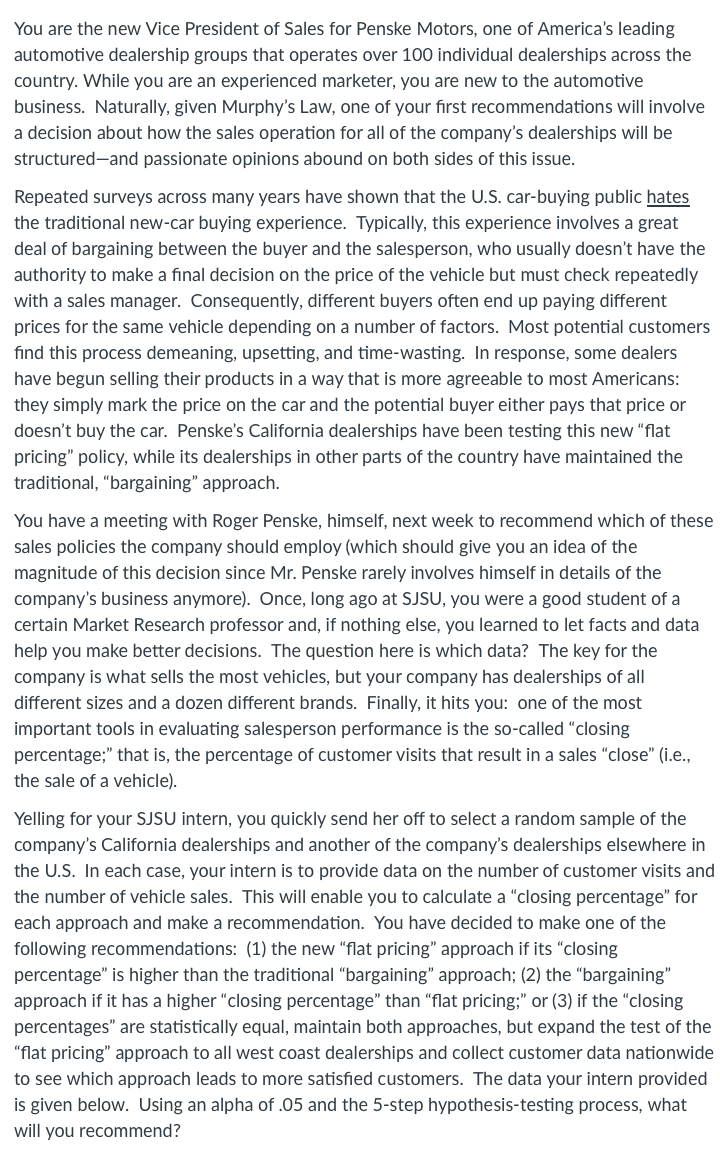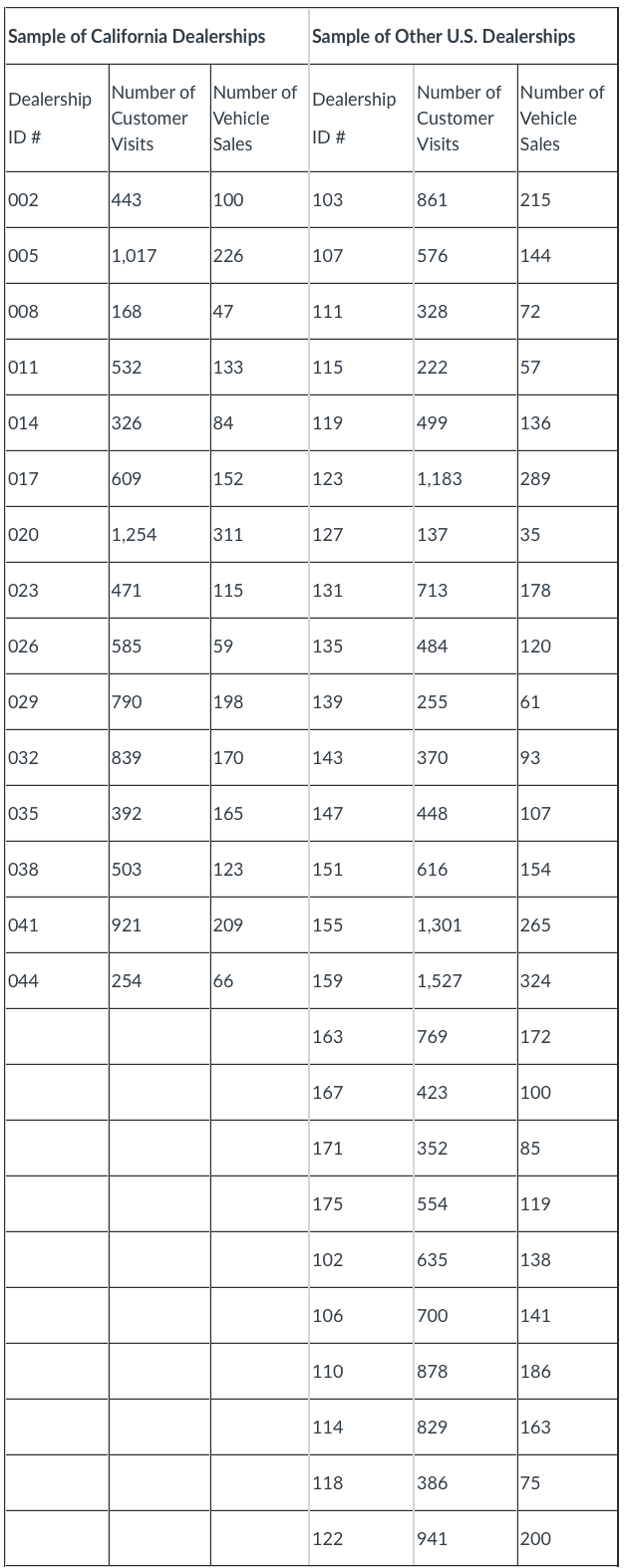Answered step by step
Verified Expert Solution
Question
1 Approved Answer
USE THE Critical Value Approach. DO NOT USE P-VALUE. You are the new Vice President of Sales for Penske Motors, one of America's leading automotive
USE THE Critical Value Approach. DO NOT USE P-VALUE.

 You are the new Vice President of Sales for Penske Motors, one of America's leading automotive dealership groups that operates over 100 individual dealerships across the country. While you are an experienced marketer, you are new to the automotive business. Naturally, given Murphy's Law, one of your first recommendations will involve a decision about how the sales operation for all of the company's dealerships will be structured-and passionate opinions abound on both sides of this issue. Repeated surveys across many years have shown that the U.S. car-buying public hates the traditional new-car buying experience. Typically, this experience involves a great deal of bargaining between the buyer and the salesperson, who usually doesn't have the authority to make a final decision on the price of the vehicle but must check repeatedly with a sales manager. Consequently, different buyers often end up paying different prices for the same vehicle depending on a number of factors. Most potential customers find this process demeaning, upsetting, and time-wasting. In response, some dealers have begun selling their products in a way that is more agreeable to most Americans: they simply mark the price on the car and the potential buyer either pays that price or doesn't buy the car. Penske's California dealerships have been testing this new "flat pricing" policy, while its dealerships in other parts of the country have maintained the traditional, "bargaining" approach. You have a meeting with Roger Penske, himself, next week to recommend which of these sales policies the company should employ (which should give you an idea of the magnitude of this decision since Mr. Penske rarely involves himself in details of the company's business anymore). Once, long ago at SJSU, you were a good student of a certain Market Research professor and, if nothing else, you learned to let facts and data help you make better decisions. The question here is which data? The key for the company is what sells the most vehicles, but your company has dealerships of all different sizes and a dozen different brands. Finally, it hits you: one of the most important tools in evaluating salesperson performance is the so-called "closing percentage;" that is, the percentage of customer visits that result in a sales "close" (i.e., the sale of a vehicle). Yelling for your SJSU intern, you quickly send her off to select a random sample of the company's California dealerships and another of the company's dealerships elsewhere in the U.S. In each case, your intern is to provide data on the number of customer visits and the number of vehicle sales. This will enable you to calculate a "closing percentage" for each approach and make a recommendation. You have decided to make one of the following recommendations: (1) the new "flat pricing" approach if its "closing percentage" is higher than the traditional "bargaining" approach; (2) the "bargaining" approach if it has a higher "closing percentage" than "flat pricing;" or (3) if the "closing percentages" are statistically equal, maintain both approaches, but expand the test of the "flat pricing" approach to all west coast dealerships and collect customer data nationwide to see which approach leads to more satisfied customers. The data your intern provided is given below. Using an alpha of .05 and the 5-step hypothesis-testing process, what will you recommend
You are the new Vice President of Sales for Penske Motors, one of America's leading automotive dealership groups that operates over 100 individual dealerships across the country. While you are an experienced marketer, you are new to the automotive business. Naturally, given Murphy's Law, one of your first recommendations will involve a decision about how the sales operation for all of the company's dealerships will be structured-and passionate opinions abound on both sides of this issue. Repeated surveys across many years have shown that the U.S. car-buying public hates the traditional new-car buying experience. Typically, this experience involves a great deal of bargaining between the buyer and the salesperson, who usually doesn't have the authority to make a final decision on the price of the vehicle but must check repeatedly with a sales manager. Consequently, different buyers often end up paying different prices for the same vehicle depending on a number of factors. Most potential customers find this process demeaning, upsetting, and time-wasting. In response, some dealers have begun selling their products in a way that is more agreeable to most Americans: they simply mark the price on the car and the potential buyer either pays that price or doesn't buy the car. Penske's California dealerships have been testing this new "flat pricing" policy, while its dealerships in other parts of the country have maintained the traditional, "bargaining" approach. You have a meeting with Roger Penske, himself, next week to recommend which of these sales policies the company should employ (which should give you an idea of the magnitude of this decision since Mr. Penske rarely involves himself in details of the company's business anymore). Once, long ago at SJSU, you were a good student of a certain Market Research professor and, if nothing else, you learned to let facts and data help you make better decisions. The question here is which data? The key for the company is what sells the most vehicles, but your company has dealerships of all different sizes and a dozen different brands. Finally, it hits you: one of the most important tools in evaluating salesperson performance is the so-called "closing percentage;" that is, the percentage of customer visits that result in a sales "close" (i.e., the sale of a vehicle). Yelling for your SJSU intern, you quickly send her off to select a random sample of the company's California dealerships and another of the company's dealerships elsewhere in the U.S. In each case, your intern is to provide data on the number of customer visits and the number of vehicle sales. This will enable you to calculate a "closing percentage" for each approach and make a recommendation. You have decided to make one of the following recommendations: (1) the new "flat pricing" approach if its "closing percentage" is higher than the traditional "bargaining" approach; (2) the "bargaining" approach if it has a higher "closing percentage" than "flat pricing;" or (3) if the "closing percentages" are statistically equal, maintain both approaches, but expand the test of the "flat pricing" approach to all west coast dealerships and collect customer data nationwide to see which approach leads to more satisfied customers. The data your intern provided is given below. Using an alpha of .05 and the 5-step hypothesis-testing process, what will you recommend Step by Step Solution
There are 3 Steps involved in it
Step: 1

Get Instant Access to Expert-Tailored Solutions
See step-by-step solutions with expert insights and AI powered tools for academic success
Step: 2

Step: 3

Ace Your Homework with AI
Get the answers you need in no time with our AI-driven, step-by-step assistance
Get Started


